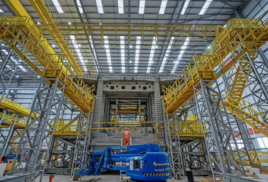HS2 Ltd has begun production of 1,000 140-tonne concrete segments that will form the deck of the 2.1-mile Colne Valley Viaduct.
The segments are being made at a temporary factory built specifically for the task. It has a volume of 105,000m (making it larger than the Royal Albert Hall) and is visible from the M25.
At peak construction, approximately 12 segments - each the size of a double-decker bus - will be cast each week using a ‘match-casting’ technique. This approach involves each segment being poured against the previous one, to ensure that the whole arch fits perfectly when reassembled onsite.
The viaduct is being built by main works contractor Align JV (comprising Bouygues Travaux Publics, Sir Robert McAlpine and VolkerFitzpatrick).
Its design is said to have been inspired by the flight of a stone skipping across the water, with a series of spans up to 80 metres long carrying the railway approximately 10 metres above lakes, the river Colne and the Grand Union Canal.
Once construction is complete, the factory and surrounding buildings will be turned into an area of chalk grassland and woodland, as part of HS2’s ‘green corridor’ project.
Work has also commenced on the 56 piers that will support the viaduct, working from north to south. Each 370-tonne pier sits on a set of concrete piles drilled up to 55 metres into the ground.
To read the full story, see RAIL 951















Login to comment
Comments
Güntürk Üstün - 24/02/2022 23:04
Construction of the UK’s longest railway bridge (the Colne Valley Viaduct) began during March 2021, with an expert team of ground engineers sinking the first of almost 300 piles that will form the foundations for the viaduct. The completion of the main deck has been anticipated to occur in mid-2024. The under construction bridge which will carry the High Speed 2 (HS2) railway over the Colne Valley Regional Park and the Grand Union Canal, in Hillingdon, west London possess a length of 2.1 miles (3.4 km) and a weight of 116 000 tonnes, will be almost a kilometre longer than the Forth Rail Bridge and make it possible the passenger trains travelling at speeds of up to 200 mph (320 kmh). Dr. Güntürk Üstün